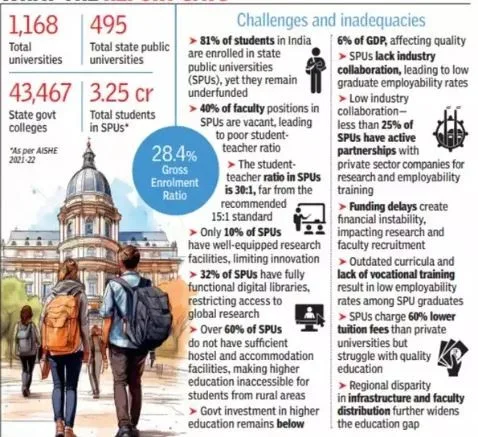Syllabus: GS2/Education
Context
- NITI Aayog launched a policy report titled ‘Expanding Quality Higher Education through States and State Public Universities’.
About
- The report is a first-of-its kind policy document in the higher education sector focused specifically on States and State Public Universities (SPUs).
- State Public University (SPU) is a university established or incorporated by a Provincial Act or by a State Act can be termed a State (Public) University.
- It provides detailed quantitative analysis on vital indicators of Quality, Funding and Financing, Governance and Employability over the last decade across the themes.
Key Findings of Report
- Highest Funding: Maharashtra leads in higher education funding, followed by Bihar and Tamil Nadu.
- Lowest Funding: Sikkim, Arunachal Pradesh, and Nagaland have the lowest higher education budgets.
- University Density: The national average university density is 0.8.
- Sikkim has the highest density of 10.3, followed by Arunachal Pradesh, Ladakh, Himachal Pradesh, Meghalaya and Uttarakhand.
- In Bihar, Uttar Pradesh, West Bengal and Maharashtra, density at the state level is below the national average.
- Female Enrolment: Kerala, Chhattisgarh and Himachal Pradesh have higher female enrolment rates than males.
Challenges
- Dearth of good quality infrastructure.
- Shortage of faculty and staff.
- Insufficient expenditure on R&D.
- There is a low enrolment of students at the MTech and Ph.D. levels, presenting a significant challenge in fostering advanced research and academic growth.
- Courses, syllabus, curriculum not being industry-ready.
- Issues in funding: They face financial challenges due to dependency on traditional revenue sources such as admission fees and state grants.
- There are administrative delays in fund sanctioning along with the lack of framework for bank loans as major challenges for funding and financing of SPUs.

Recommendations
- It has presented nearly 80 policy recommendations to address various issues related to four areas of SPUs: quality of education; funding and financing; governance; and employability among students enrolled in them.
- Increasing the combined investment of Centre and States on education to 6% of GDP as recommended in NEP 2020.
- Increasing the R&D Investment (public and private) to 2% of GDP as recommended in the Economic Survey 2017-18.
- Clusters of SPUs should identify 2 to 3 local issues and establish Centres of Excellence dedicated to addressing these challenges.
- States may consider establishing a finance agency similar to the Higher Education Financing Agency (HEFA), dedicated specifically to SPUs.
- HEFA is a joint venture of the Centre and Canara Bank set up in 2017.
- This agency should focus on bolstering infrastructure and research facilities.
Source: TH
Previous article
News In Short 10-2-2025
Next article
India-UK Defence Collaboration